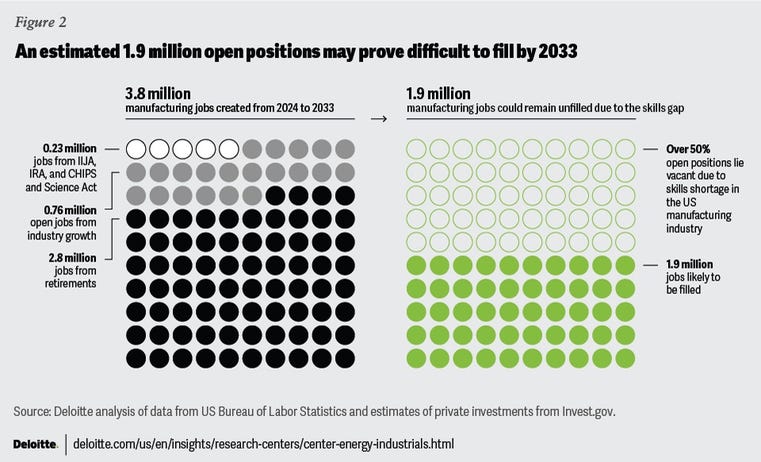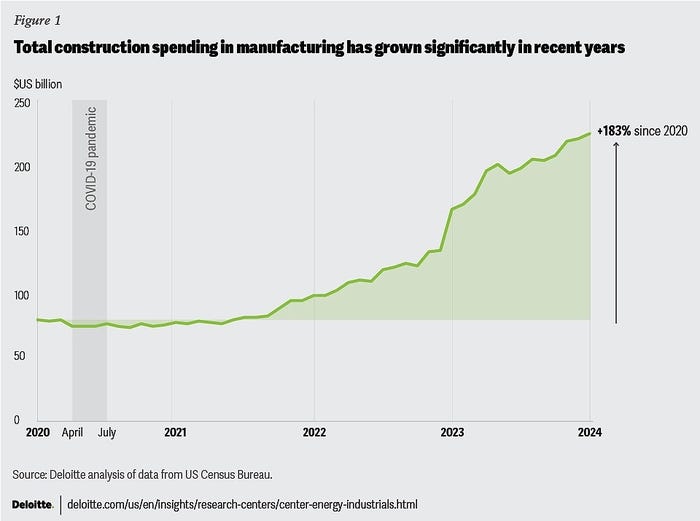Manufacturers Will Need 3.8M New Workers by 2033
Expanding US manufacturing will exacerbate the shortage of skilled plant workers over the coming decade.
April 3, 2024

At a Glance
- 1.9 million jobs could remain unfilled if manufacturers are not able to address the skills and applicant gaps.
- In the last five years, there has been a 75% increase in demand for simulation and software skills in manufacturing.
- Manufacturers face an increasing demand for training to equip workers with new skills.
Key legislation such as the CHIPS and Science Act has bolstered investment in US manufacturing, driving up the need for industrial workers. This comes at a time when the manufacturing industry is already hard-pressed to find sufficient labor. While many manufacturers have turned to automation to solve the crisis, skilled workers are still hard to find.
The problem is expected to worsen, not improve, over the coming decade. Deloitte and the Manufacturing Institute (MI) have released a report, Taking charge: Manufacturers support growth with active workforce strategies, that reveals that the manufacturing sector could need as many as 3.8 million new employees between 2024 and 2033.
The report explores the challenges facing the manufacturers as they seek to fill jobs. The U.S. Bureau of Labor Statistics’ Job Openings and Labor Turnover Summary (JOLTS) shows little change in the number of job openings as of the end of February. The talent gap is stubbornly persistent.
This Deloitte chart based on U.S. Bureau of Labor Statistics data shows the extent of the jobs gap in manufacturing:

Image courtesy of Deloitte.
The COVID Recovery Didn’t Solve the Labor Issue
The US manufacturing industry came out of the pandemic on a strong growth trajectory. Continued growth is expected over the next 10 years as companies work to meet evolving customer demands, de-risk their supply chains, and leverage government incentives and policies. Because of substantial growth in the sector, US manufacturing faces a skills gap and tight labor market that will pester the sector for years.
This chart shows the growth in the construction of manufacturing facilities. The sharp expansion indicates further worker shortfalls going forward:

Image courtesy of Deloitte.
Key findings from Deloitte’s report:
Despite the opportunity for 3.8 million jobs, 1.9 million could remain unfilled if manufacturers are not able to address the skills and applicant gaps. That could represent nearly 5 in 10 of the skilled open positions.
The demand for digital skills is accelerating. In the last five years, there has been a 75% increase in demand for simulation and simulation software skills, sought mostly for technology-enabled production or testing roles, Deloitte and MI found. Further, roles like statisticians, data scientists, engineers, logisticians, computer and information systems managers, software developers, and industrial maintenance technicians are projected to grow at the fastest pace between 2022-2032.
Evolving workforce priorities refocus on values and skills. Nearly half (47%) of respondents indicated that flexible work arrangements (including flexible shifts, shift swapping and split shifts) are most impactful for retaining employees. In addition, employers are facing an increasing demand for training to equip existing workers with new skills.
To meet the talent need, manufacturers expand the talent pool. More than nine out of 10 surveyed manufacturers said they are forming at least one partnership to improve job attraction and retention, and on average, they are partnering with four or more. The top five partnership types are: technical colleges (73%), industry associations (58%), universities (48%), state and regional economic development agencies (47%), and K-12 schools (44%).
About the Author(s)
You May Also Like





